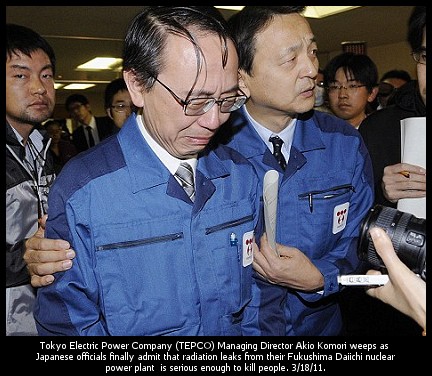
We're just a day or so from the two week mark since disaster struck Japan on March 11th. Estimates now are that the death toll is likely to top more than 27,000 people killed in the great Tohoku Earthquake and its subsequent tsunami (with a peak wave now estimated to have 77 feet at its highest.)
Some quick math comparing the relative populations of Japan to the U.S. suggest that, had such a disaster struck this country, some 68,000 lives would have been lost in a single day. To further appreciate the size of Japan's disaster, the cost of damage is estimated to be around $300 billion. In the U.S., the cost of the damage wrought by Hurricane Katrina, one of our greatest disasters, is estimated to be "only" around $81 billion, according to Reuters.
Friday is already well under way at the Fukushima Daiichi nuclear power plant, and reports last night and today suggest a calm, of sorts, at least in regard to the chain of continuing disasters we've seen there over much of the last two weeks. Though, like the photo that opens this article above, that calm may mask other problems, or be shattered in an instant, as has frequently been the case just after we post one of these "things seem to be stabilizing" articles.
Nonetheless, there does seem to be some stabilization at Fukushima's Daiichi power plant and its six troubled reactors at this moment, even as three plant workers were contaminated after stepping into 30 centimeters of radioactive water yesterday (two were sent to the hospital with burns on their skin as the radiation they came into contact with is said by TEPCO to have been 10,000 times normal levels); irradiated tap water worries ease somewhat in Tokyo, but spread to neighboring prefectures; and as scientists grapple with attempting to determine the full extent of the damage at the nuclear plant and the radiation dangers to the rest of the country, and across the globe, as data now suggests releases of dangerous radioactive cesium-137 have so far reached approximately 50% of that released at Chernobyl twenty-five years ago next month.
But first, before some of that gloomier news below, a (happily) very quick update on the latest status of each of the six crippled nuclear reactors...


 Campaign to 'Impeach Trump Again' Gains Fresh Momentum: 'BradCast' 4/29/25
Campaign to 'Impeach Trump Again' Gains Fresh Momentum: 'BradCast' 4/29/25 'Green News Report' 4/29/25
'Green News Report' 4/29/25
 And Then They Came for the Judges...: 'BradCast' 4/28/25
And Then They Came for the Judges...: 'BradCast' 4/28/25 Sunday 'Desperation' Toons
Sunday 'Desperation' Toons Trump EPA Guts Enviro Justice Office: 'BradCast' 4/24/25
Trump EPA Guts Enviro Justice Office: 'BradCast' 4/24/25 'Green News Report' 4/24/25
'Green News Report' 4/24/25 Nation's Largest Broadcaster Hoaxes Viewers to Help Gut FCC Rules: 'BradCast' 4/23/25
Nation's Largest Broadcaster Hoaxes Viewers to Help Gut FCC Rules: 'BradCast' 4/23/25 Trump's FCC on Precipice of Ending All Limits on Corporate Control of Local TV Stations
Trump's FCC on Precipice of Ending All Limits on Corporate Control of Local TV Stations GOP Earth Day 2025 Hypocrisies and Dilemmas: 'BradCast' 4/22/25
GOP Earth Day 2025 Hypocrisies and Dilemmas: 'BradCast' 4/22/25 'Green News Report' 4/22/25
'Green News Report' 4/22/25 Pope Francis Dies, Trump Still Alive and Criming: 'BradCast' 4/21/25
Pope Francis Dies, Trump Still Alive and Criming: 'BradCast' 4/21/25 Sunday
Sunday  Sunday 'Zero Day' Toons
Sunday 'Zero Day' Toons 'Green News Report' 4/10/25
'Green News Report' 4/10/25 Soc. Sec. Expert Warns DOGE of Collapse, Privatization: 'BradCast' 4/10/2025
Soc. Sec. Expert Warns DOGE of Collapse, Privatization: 'BradCast' 4/10/2025 Trump Blinks, Chaos Reigns, Markets Spike Amid Tariff 'Pause': 'BradCast' 4/9/25
Trump Blinks, Chaos Reigns, Markets Spike Amid Tariff 'Pause': 'BradCast' 4/9/25 SCOTUS Deportation Ruling Grimmer Than First Appears: 'BradCast' 4/8/25
SCOTUS Deportation Ruling Grimmer Than First Appears: 'BradCast' 4/8/25 Cliff Diving with Donald: 'BradCast' 4/7/25
Cliff Diving with Donald: 'BradCast' 4/7/25 'Mob Boss' Trump's Trade Sanctions Tank U.S., World Markets: 'BradCast' 4/3/25
'Mob Boss' Trump's Trade Sanctions Tank U.S., World Markets: 'BradCast' 4/3/25 Crawford Landslide in WI; Booker Makes History in U.S. Senate: 'BradCast' 4/2/25
Crawford Landslide in WI; Booker Makes History in U.S. Senate: 'BradCast' 4/2/25 Judge Ends Challenge to GA's Unverifiable, Insecure Vote System: 'BradCast' 4/1/25
Judge Ends Challenge to GA's Unverifiable, Insecure Vote System: 'BradCast' 4/1/25 Bad Court, Election News for Trump is Good News for U.S.: 'BradCast' 3/31
Bad Court, Election News for Trump is Good News for U.S.: 'BradCast' 3/31
 VA GOP VOTER REG FRAUDSTER OFF HOOK
VA GOP VOTER REG FRAUDSTER OFF HOOK Criminal GOP Voter Registration Fraud Probe Expanding in VA
Criminal GOP Voter Registration Fraud Probe Expanding in VA DOJ PROBE SOUGHT AFTER VA ARREST
DOJ PROBE SOUGHT AFTER VA ARREST Arrest in VA: GOP Voter Reg Scandal Widens
Arrest in VA: GOP Voter Reg Scandal Widens ALL TOGETHER: ROVE, SPROUL, KOCHS, RNC
ALL TOGETHER: ROVE, SPROUL, KOCHS, RNC LATimes: RNC's 'Fired' Sproul Working for Repubs in 'as Many as 30 States'
LATimes: RNC's 'Fired' Sproul Working for Repubs in 'as Many as 30 States' 'Fired' Sproul Group 'Cloned', Still Working for Republicans in At Least 10 States
'Fired' Sproul Group 'Cloned', Still Working for Republicans in At Least 10 States FINALLY: FOX ON GOP REG FRAUD SCANDAL
FINALLY: FOX ON GOP REG FRAUD SCANDAL COLORADO FOLLOWS FLORIDA WITH GOP CRIMINAL INVESTIGATION
COLORADO FOLLOWS FLORIDA WITH GOP CRIMINAL INVESTIGATION CRIMINAL PROBE LAUNCHED INTO GOP VOTER REGISTRATION FRAUD SCANDAL IN FL
CRIMINAL PROBE LAUNCHED INTO GOP VOTER REGISTRATION FRAUD SCANDAL IN FL Brad Breaks PA Photo ID & GOP Registration Fraud Scandal News on Hartmann TV
Brad Breaks PA Photo ID & GOP Registration Fraud Scandal News on Hartmann TV  CAUGHT ON TAPE: COORDINATED NATIONWIDE GOP VOTER REG SCAM
CAUGHT ON TAPE: COORDINATED NATIONWIDE GOP VOTER REG SCAM CRIMINAL ELECTION FRAUD COMPLAINT FILED AGAINST GOP 'FRAUD' FIRM
CRIMINAL ELECTION FRAUD COMPLAINT FILED AGAINST GOP 'FRAUD' FIRM RICK SCOTT GETS ROLLED IN GOP REGISTRATION FRAUD SCANDAL
RICK SCOTT GETS ROLLED IN GOP REGISTRATION FRAUD SCANDAL VIDEO: Brad Breaks GOP Reg Fraud Scandal on Hartmann TV
VIDEO: Brad Breaks GOP Reg Fraud Scandal on Hartmann TV RNC FIRES NATIONAL VOTER REGISTRATION FIRM FOR FRAUD
RNC FIRES NATIONAL VOTER REGISTRATION FIRM FOR FRAUD EXCLUSIVE: Intvw w/ FL Official Who First Discovered GOP Reg Fraud
EXCLUSIVE: Intvw w/ FL Official Who First Discovered GOP Reg Fraud GOP REGISTRATION FRAUD FOUND IN FL
GOP REGISTRATION FRAUD FOUND IN FL






















 Today on my show on
Today on my show on 
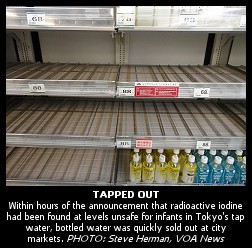 The biggest news last night was the announcement by the Tokyo Metropolitan Government that radioactive iodine levels in the city's municipal tap water has now increased to levels that are no longer safe for infants. That, according to
The biggest news last night was the announcement by the Tokyo Metropolitan Government that radioactive iodine levels in the city's municipal tap water has now increased to levels that are no longer safe for infants. That, according to 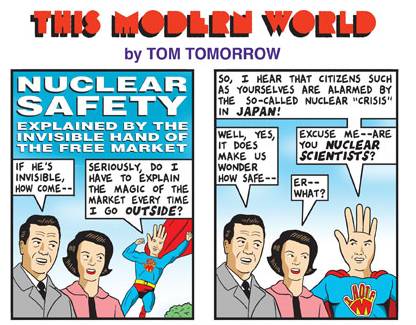
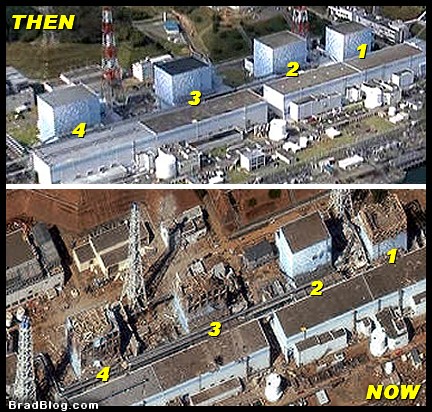

 To what extent has
To what extent has  Guest Blogged by Lizz Winstead
Guest Blogged by Lizz Winstead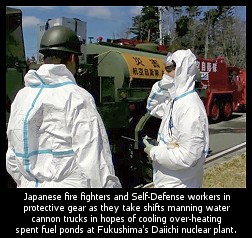 It's probably too early to breathe a full sigh of relief [Update: Apparently it is. See our late UPDATES at bottom of article.], but encouraging signs continue to come from officials concerning the state of the six nuclear reactors (and their accompanying spent fuel pools) at the badly damaged Fukushima Daiichi power plant in Japan.
It's probably too early to breathe a full sigh of relief [Update: Apparently it is. See our late UPDATES at bottom of article.], but encouraging signs continue to come from officials concerning the state of the six nuclear reactors (and their accompanying spent fuel pools) at the badly damaged Fukushima Daiichi power plant in Japan.
 At Fukushima today, only a bit more noticed,
At Fukushima today, only a bit more noticed, 